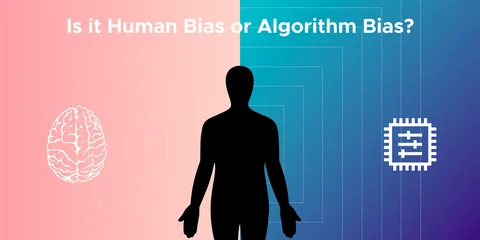Introduction
Artificial Intelligence AI has ushered in a new era of efficiency, automation, and personalized experiences. From predictive analytics to autonomous systems, its applications span every major industry. However, alongside its vast potential, AI carries inherent risks that, if left unchecked, could undermine the very societal structures it promises to enhance. This article explores three critical and interrelated threats within AI systems: bias, privacy erosion and loss of human control.
As AI becomes increasingly integrated into public and private decision making processes, addressing these risks is not a theoretical exercise it is a matter of ethical governance, legal compliance, and public trust. This piece serves as a comprehensive, actionable guide to understanding and mitigating the darker dimensions of AI.

Reinforcing Inequity Through Data
What Is Bias in AI?
Algorithmic bias occurs when an AI system produces systematically prejudiced outcomes that disadvantage certain groups. This bias can stem from multiple sources: imbalanced training data, flawed feature engineering, skewed labeling practices, or biased model objectives.
AI does not invent bias it reflects and often amplifies existing societal patterns encoded in historical data. The concern is particularly acute in sectors like healthcare, hiring, law enforcement, and finance, where decisions significantly impact individual lives.
Real World Examples
- Recruitment Algorithms: AI tools trained on past hiring data have favored male applicants over female ones, reflecting historical workplace imbalances.
- Facial Recognition: Studies have shown error rates for facial recognition systems are significantly higher for darker skinned individuals, particularly women.
- Credit Scoring: Models have penalized applicants based on indirect proxies for race or socioeconomic status, even when overtly discriminatory variables were excluded.
- Predictive Policing: AI used in criminal justice has disproportionately targeted minority communities, reinforcing cycles of over policing.
Structural Implications
When deployed at scale, these biases entrench systemic inequalities. In developing regions, the risk of data colonialism where systems are trained on data harvested from marginalized populations without ethical safeguards exacerbates power imbalances between the Global North and South.
Mitigation Strategies
- Curate diverse, representative datasets
- Apply algorithmic fairness metrics e.g., equal opportunity, demographic parity
- Utilize adversarial debiasing and fairness aware modeling
- Conduct independent bias audits
- Ensure human in the loop oversight for high stakes decisions
Bias mitigation must begin at the dataset level and continue through model development, deployment, and post deployment monitoring.

AI and Privacy
Why AI Compromises Privacy
AI systems rely heavily on large scale data to function effectively. This data often includes personal identifiers, behavioral patterns, location information, and sensitive metadata. Unlike traditional data systems, AI can generate inferences from non sensitive inputs predicting political affiliation, health status, or financial stability without direct disclosure.
Key concerns include:
- Involuntary data collection through apps, wearables, and surveillance systems
- Data re identification risks, where anonymized data is linked back to individuals
- Inferred attributes such as sexuality, religion, or political views from innocuous digital traces
- Model inversion attacks, where adversaries extract personal information from trained models
- Deepfakes and synthetic identities, used to mislead, impersonate, or manipulate
Case Studies
- Voice Assistants: Devices have been found to retain audio beyond intended use, posing risks of accidental surveillance.
- Health AI Systems: Training diagnostic models on improperly secured medical data has led to unauthorized access and re identification of patients.
- Social Media Platforms: Algorithms have inferred user traits and served hyper personalized content that exploits behavioral vulnerabilities.
Legal and Ethical Implications
Frameworks such as the General Data Protection Regulation GDPR, California Consumer Privacy Act CCPA and UAE Data Protection Law impose strict conditions on data collection, processing, and inference. However, enforcement lags behind the pace of AI development.
Privacy Preserving Techniques
- Differential Privacy: Adding statistical noise to data to obscure individual contributions
- Federated Learning: Training models across decentralized devices without centralizing raw data
- Secure Multiparty Computation: Allowing computation on encrypted data
- Synthetic Data Generation: Using generative models to produce privacy safe datasets
- Access Controls and Encryption Protocols
These technical measures must be supported by strong governance, organizational accountability, and informed user consent.
Control and Autonomy
The Black Box Challenge
Modern AI, particularly deep learning, often operates as a black box producing outputs without transparent logic. Even the engineers behind these models may struggle to explain why a particular decision was made.
This opacity undermines:
- Accountability in sensitive sectors such as justice or healthcare
- Trust among users, regulators, and the public
- Recourse for individuals affected by adverse decisions
Automation Creep and Decision Delegation
- Loss of oversight: Humans become passive recipients of algorithmic outputs
- Behavioral nudging: Recommendation systems subtly shape user preferences without consent
- Algorithmic determinism: Once embedded in infrastructure, AI decisions become difficult to contest or reverse
- Control centralization: A handful of corporations or governments dominate AI infrastructure, concentrating influence over knowledge, behavior, and economic flows
Pathways to Preserve Human Control
- Explainable AI XA: Implement tools that provide clear justifications for model decisions
- Auditability: Maintain logs, input and output tracking, and traceability protocols
- Human in the loop design: Ensure critical decisions e.g., medical diagnosis, parole denial are reviewed by qualified professionals
- Fallback mechanisms: If an AI system fails, override protocols or safe defaults must be available
- Ethical AI governance boards: Include diverse perspectives in oversight, including civil society, legal experts, and affected communities
Interconnected Challenges
AI developers frequently face tension between desirable objectives:
- Fairness vs Accuracy: Optimizing for overall model performance may exacerbate subgroup errors
- Transparency vs Security: Revealing how a model works may expose it to gaming or IP theft
- Privacy vs Utility: Obfuscating data for privacy can reduce model effectiveness
- Control vs Efficiency: Maintaining human oversight can slow down automated processes
These are not merely technical issues but strategic decisions that require organizational alignment and ethical clarity.
Frameworks for Responsible AI
Leading AI institutes and global agencies have proposed guiding frameworks. Common principles include:
- Accountability: Clear assignment of responsibility for outcomes
- Fairness: Equitable treatment across demographic groups
- Transparency: Model processes and outcomes must be understandable
- Robustness: Models must function reliably across use cases
- Human centricity: AI should augment not replace human judgment
Lifecycle Governance
AI ethics must be embedded throughout the system lifecycle:
- Data Acquisition: Consent, provenance tracking, bias evaluation
- Model Training: Fairness testing, interpretability evaluation
- Deployment: Monitoring, access control, override protocols
- Post deployment: Drift detection, performance audits, user feedback
Global Case Studies
COMPAS US
The COMPAS algorithm used for criminal risk assessment was found to disproportionately label Black defendants as high risk compared to white defendants with similar records. Despite being used in sentencing and parole decisions, its opacity made appeals difficult.
Facial Recognition UK US China
Facial recognition systems used in public surveillance have exhibited high error rates and have been criticized for enabling mass monitoring without consent. Some jurisdictions have banned or paused deployment.
Healthcare AI Global
In multiple countries, diagnostic AI tools underperformed on minority patients due to underrepresentation in training data, highlighting the need for diverse datasets in medical contexts.
Cambridge Analytica
Though not purely an AI case, this scandal underscored how behavioral data can be weaponized to influence elections, showing how loss of control over data can result in societal manipulation.
Recommendations for Stakeholders
For Developers
- Integrate fairness and bias metrics from day one
- Prioritize model interpretability in high stakes domains
- Document data provenance and assumptions
- Perform regular audits, even post deployment
For Enterprises
- Establish internal AI ethics boards
- Provide transparency to users and regulators
- Train staff in AI ethics and regulatory requirements
- Monitor AI systems for unintended outcomes
For Policymakers
- Define legal standards for algorithmic accountability
- Fund public infrastructure for independent audits
- Encourage cross border harmonization of AI governance
- Mandate algorithmic transparency in public sector use
For Users and Citizens
- Demand transparency on how decisions are made
- Exercise rights to access and correct personal data
- Support privacy enhancing tools and alternatives
- Participate in public consultations on AI legislation
What is algorithmic bias in AI?
Algorithmic bias occurs when an AI system produces unfair or discriminatory outcomes due to biased training data, flawed assumptions, or model design.
How does AI pose a threat to privacy?
AI often collects and infers sensitive data from user behavior, which can lead to unauthorized profiling, surveillance, or data misuse.
What makes AI systems difficult to control?
Many AI models operate as black boxes meaning their decision-making processes are opaque, making it hard to monitor, explain, or override them.
Can AI amplify existing social inequalities?
Yes. If trained on biased data, AI systems can reinforce historical discrimination in areas like hiring, lending, and law enforcement.
What is a model inversion attack?
It is a method by which attackers reverse-engineer personal data from a trained AI model, compromising user privacy.
Why is explainability important in AI?
Explainability allows stakeholders to understand how an AI system made a decision, enabling accountability, trust, and legal compliance.
What legal frameworks address AI related privacy issues?
Laws like the GDPR, CCPA California and UAE Data Law regulate how data is collected, processed, and used in AI systems.
What is differential privacy?
It is a technique that adds noise to data or queries to protect individual privacy while preserving overall data utility.
How can we mitigate AI bias?
By using diverse training data, fairness aware algorithms, independent audits, and maintaining human oversight in decision loops.
Who is responsible for AI decisions developers or users?
Responsibility typically lies with the deploying organization, but developers, vendors, and policymakers also share ethical and legal accountability.
Conclusion
Artificial Intelligence is not inherently dangerous but it is inherently powerful. Like all powerful technologies, it must be governed wisely. The threats of algorithmic bias, privacy violation, and autonomy erosion are not theoretical they are already shaping lives and institutions globally.
Navigating the dark side of AI requires multi disciplinary collaboration, robust regulation, and cultural awareness. Ethical design, transparent governance, and an unwavering focus on human dignity must guide the future of AI. As we advance into this transformative era, the measure of progress will not be in model accuracy alone but in our ability to align technology with equity, freedom, and trust.
